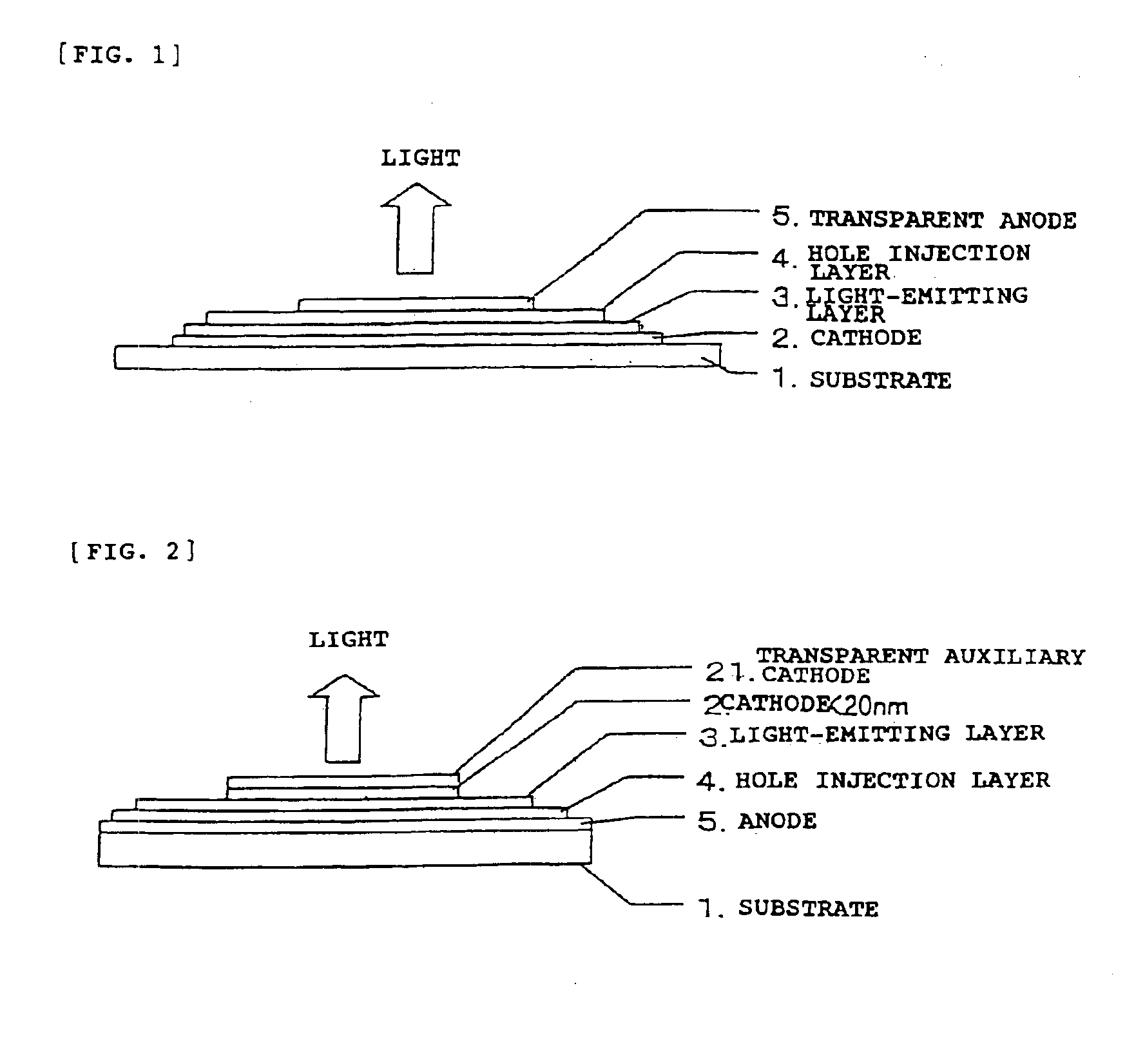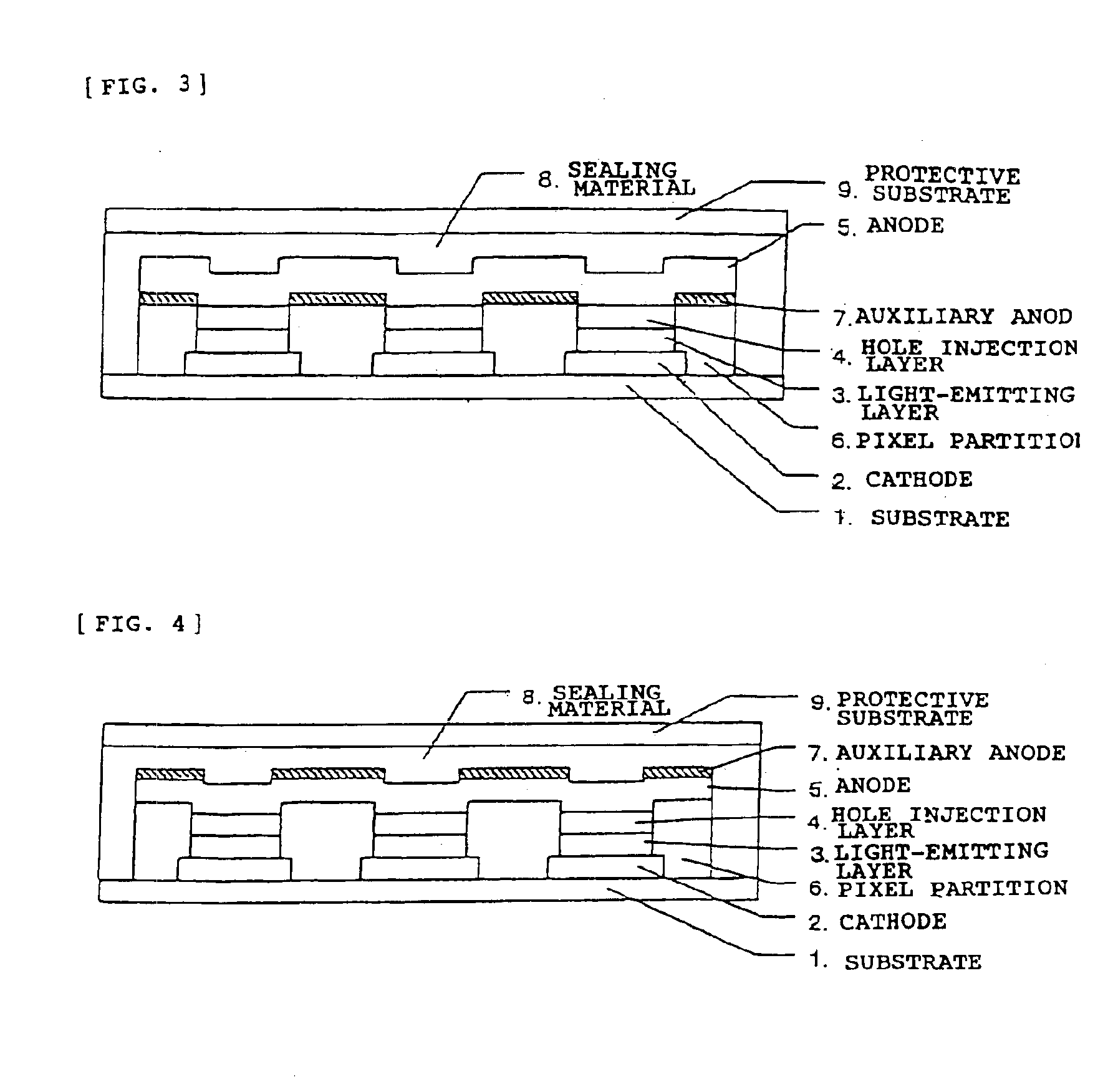Organic electroluminescence device and manufacturing method therefor
a technology of electroluminescence device and manufacturing method, which is applied in the direction of discharge tube/lamp details, discharge tube luminescnet screen, organic semiconductor device, etc., can solve the problems of long life and low consumption of electric power, and achieve the effect of preventing the decrease of contrast, long life and low electric power
- Summary
- Abstract
- Description
- Claims
- Application Information
AI Technical Summary
Benefits of technology
Problems solved by technology
Method used
Image
Examples
embodiment 1
In this embodiment, an example will be described in which at least a cathode, a light-emitting layer, a transparent anode, and a hole transport layer and / or a hole injection layer are formed on a substrate in this order. In FIG. 1, a cross-sectional view of an organic EL device according to this embodiment is shown.
First, a cathode 2 was formed on a substrate 1. Next, a light-emitting layer 3 was formed, and in addition, a hole injection layer 4 was formed. Next, an anode 5 was formed, and in addition, a sealing layer (not shown in the figure) was formed.
When a voltage was applied between electrodes of the organic EL device thus formed, light was emitted from the sealing layer side.
For the substrate 1 used in this embodiment, in addition to a glass substrate, a metal, a semiconductor, a plastic, or the like may be used, and an opaque substrate may also be used.
For the cathode 2 used in this embodiment, aluminum, magnesium, lithium, or calcium may be used, and in addition, the alloy ...
embodiment 2
In this embodiment, a particular example will be described in which the cathode is formed of a laminate formed of at least one type of conductive material and a metal oxide or fluoride. By using the method of Embodiment 1, when patterning was performed in a photolithographic step after an aluminum film was formed as a cathode, and an oxygen plasma treatment was then performed, an oxide layer 20 Å thick was formed on the surface. By using this substrate provided with the cathode, when an organic EL device was formed by performing the outstanding steps in Embodiment 1, the luminous efficiency thereof was two times (0.2 lm / W) that obtained in Embodiment 1.
Instead of the oxygen plasma treatment performed on the surface of the cathode, when lithium fluoride 20 Å thick was deposited, the luminous efficiency was 0.5 lm / W.
The light-emitting layer 3 used in this embodiment was formed of a polyfluorene material and was formed by spin coating. The hole injection layer 4 was formed by spin coat...
embodiment 3
In this embodiment, an example of the structure shown in FIG. 3 will be described in which a plurality of cathodes 2 corresponding to a plurality of light-emitting pixels are formed on a substrate 1, pixel partitions 6 formed of an insulating material are formed between the light-emitting pixels, and auxiliary anodes 7 formed of a conductive material having approximately equivalent patterns to those of the pixel partitions 6 are formed thereon.
A particular example is described below. First, after the cathodes 2 were patterned, the pixel partitions 6 were formed of a polyimide and were patterned, and subsequently, a film formed of tantalum 1,000 Å thick was formed and was then patterned so as to form the same pattern as that of the pixel partition 6. Next, a film formed of lithium fluoride 20 Å thick was formed on the entire surface, three types of polyfluorene materials emitting red, green, and blue light were each dissolved in isodurene, and the films thereof as the light-emitting ...
PUM
 Login to View More
Login to View More Abstract
Description
Claims
Application Information
 Login to View More
Login to View More - R&D
- Intellectual Property
- Life Sciences
- Materials
- Tech Scout
- Unparalleled Data Quality
- Higher Quality Content
- 60% Fewer Hallucinations
Browse by: Latest US Patents, China's latest patents, Technical Efficacy Thesaurus, Application Domain, Technology Topic, Popular Technical Reports.
© 2025 PatSnap. All rights reserved.Legal|Privacy policy|Modern Slavery Act Transparency Statement|Sitemap|About US| Contact US: help@patsnap.com



